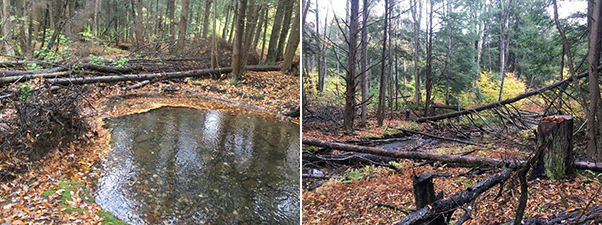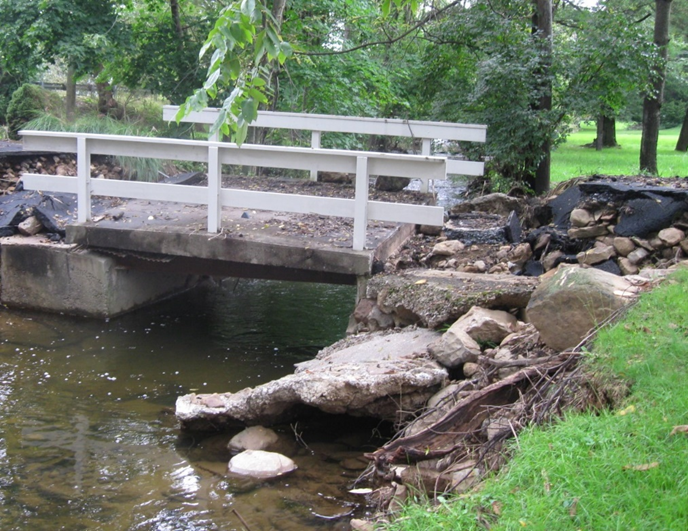Flood-Damaged Bridges & Culverts and Emergency Debris Removal
Several authorizations & options are available to state agencies, municipalities, utilities, private citizens, and others to allow the repairs and replacement of bridges and other water obstructions and encroachments that have been damaged or lost due to flooding. There are also several authorizations that exist to allow streambank stabilization or other stream work when there is an imminent threat to public health and safety or the environment that requires immediate remedial action. Summary descriptions of these authorizations are listed below and can be found on the
permitting and authorizations page. This information is a summary and does not modify the eligibility requirements of the applicable authorizations.
Accordion
Expand AllClick here for a more accessible versionOne way to keep debris from blocking a water opening is routine maintenance. Routine maintenance is included in Chapter 105 water obstruction and encroachments, and Chapter 105 requires owners to conduct such maintenance. Conducting routine maintenance is a condition of all water obstruction and encroachment permits and can, if done properly, minimize the buildup of debris after large storm events. It is important to maintain the hydraulic opening of the water obstruction and encroachment to help prevent future damage from flooding. Routine channel maintenance is authorized and limited to a maximum of 50 feet upstream and downstream of the bridge or culvert and should be conducted in accordance with DEPs Standards for Channel Cleaning at Bridges and Culverts.
Local governments are reminded to document their costs for the removal or repair of water obstructions and encroachments that have been damaged or lost due to flooding and debris removal for later possible reimbursement by the federal government. Pictures of debris, equipment and labor costs can be kept to document removal costs. Be sure to take pictures of the damage before any work has begun. Questions about documentation should be directed to county emergency management officials and the Pennsylvania Emergency Management Agency (PEMA).
Unsure of What Approvals Are Needed?

Need help determining if permits or other regulatory requirements from DEP are required for bridge and culvert maintenance and repair? DEP’s Bridge and Culvert Maintenance & Repair Tool is an online interactive tool designed to assist bridge and culvert owners in determining what, if any, permit and notification requirements are needed for bridge and culvert maintenance and repair. By answering questions about the bridge and culvert, the nature of the proposed work, and to avoid delays the tool will direct you on how to move forward with your project.
Woody Material and Stream Habitat
Woody material can be debris and form hazards for man-made structures in streams, such as bridges and culverts. It can clog structures, and cause erosion and present hazards not only to the structures, but to the public. While the structures are critical to be maintained in an opening and functional way, woody material such as trees logs, and branches are also a critical component for the natural functions of streams and fish habitat. DEP recommends that only material that presents a risk to life and property, or a water obstruction or encroachment be removed from streams. In some instances, wood debris “jams” can protect downstream structures as well by collecting woody material transported during storms. In addition, woody material in streams provides organic material to support the aquatic food chain, habitat for fish and other species, and provides stream channel stability and floodplain connectivity. In fact, utilizing large woody debris is a growing cost-effective stream restoration approach.
See the webinars on Large Woody Material for Stream Restoration course on Clean Water Academy.

Activities that Do Not Require a Permit or Pre-approval from DEP
Removal of flood debris such as trees, logs, brush, or similar material from the stream channel, where the work with machinery (i.e. tractors, excavators, etc.) is accomplished from the bank, can be conducted in most cases without authorization from or notification to DEP. However, this does not include the removal of stream gravel or sediment deposits. The use of winches, chainsaws, other handheld machinery to remove woody debris from within the stream can also be conducted in most cases without authorization from or notification to DEP. The removal of debris from within a stream channel should be done in such a manner as to avoid altering the stream channel or banks, including vegetation, woody, or otherwise.
DEP has helpful tools and information to assist and educate on the requirements and when a water obstruction and encroachment permit or approval is not required. They are:
Pre-Approval from DEP
When removal of debris consisting of woody debris or trash requires equipment (such as tractors or excavators) to enter the stream in order to facilitate the removal,
DEP should be contacted to assist in determining what if any authorizations may be necessary. Depending on the access to the stream, and other work, written authorization may be necessary. DEP can assist in obtaining this authorization in writing prior to conducting the removal.
Prior to removing debris, such as trees, logs, brush, or similar material from streams,
contact the local DEP regional office. DEP may provide approvals over the telephone for the emergency removal of debris blocking streams, especially where the debris may cause a backwater condition and increase the potential for more flooding. In larger debris areas or if you need advice on how to remove debris, DEP staff can visit a site to assist in determining the best way to remove debris. Depending on the scope of the project, authorization may also be required from the U.S. Army Corps of Engineers (USACE).
Existing Permits
If a structure has an existing water obstruction and encroachment permit, maintenance is included in the permit if it was issued after July 1, 1979. If there is an existing permit which authorizes maintenance, repairs (but not replacements or modifications from original specifications) may be conducted under the terms of the existing permit as maintenance. This maintenance includes the removal of sediment and gravel deposits in accordance with DEP’s
Standards for Channel Cleaning At Bridges and Culverts, which limits the depth, and work to 50 feet upstream and downstream. All materials should be removed and disposed of in a safe, upland area and not in any wetlands, floodway, or floodplain.

Activities that Do Not Require a Permit but DO Require Notification to DEP
Notification for structures which have collapsed or are about to collapse is required, which includes: removal of bridges or culverts that have collapsed either in their entirety or a portion thereof; the existence of an unusual circumstance threatening the structural integrity of a bridge or culvert; or situations where a bridge or culvert needs to be repaired or removed. The owner of the structure needs to immediately inform DEP’s regional Waterways and Wetlands Program to inform them and the collapsed portion of the structure should then be removed outside the floodplain of the stream.
DEP’s online
Bridge & Culvert Maintenance & Repair Tool can also assist and provide assistance in determining requirements in these situations.
Notification to DEP is required to remove debris that consists of stream gravels or sediments that has accumulated in and around existing bridges and culverts (within 50 feet up and downstream). This can be conducted under maintenance if there is an existing permit which authorizes maintenance for the structure, and the
Standards for Channel Cleaning at Bridges and Culverts is followed.

Emergency Permits
DEP can issue an
emergency permit or
other permit authorization for the repair or replacement of damaged culverts, bridges, or other stream crossings, or for streambank stabilization or other stream work where there is an imminent threat to public health and safety or the environment that requires immediate remedial action. Emergency permits generally expire after 60 days, but DEP may extend the coverage period to an additional 60 days. Emergency permits may require an on-site inspection by DEP or the delegated conservation district personnel prior to issuance of the emergency permit. Under certain circumstances, emergency permits can be authorized without this inspection, provided DEP is contacted and the necessary information is provided. If any of the above scenarios do not fit the specific circumstance,
contact DEP to discuss other permitting options.
